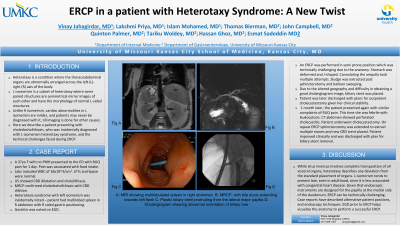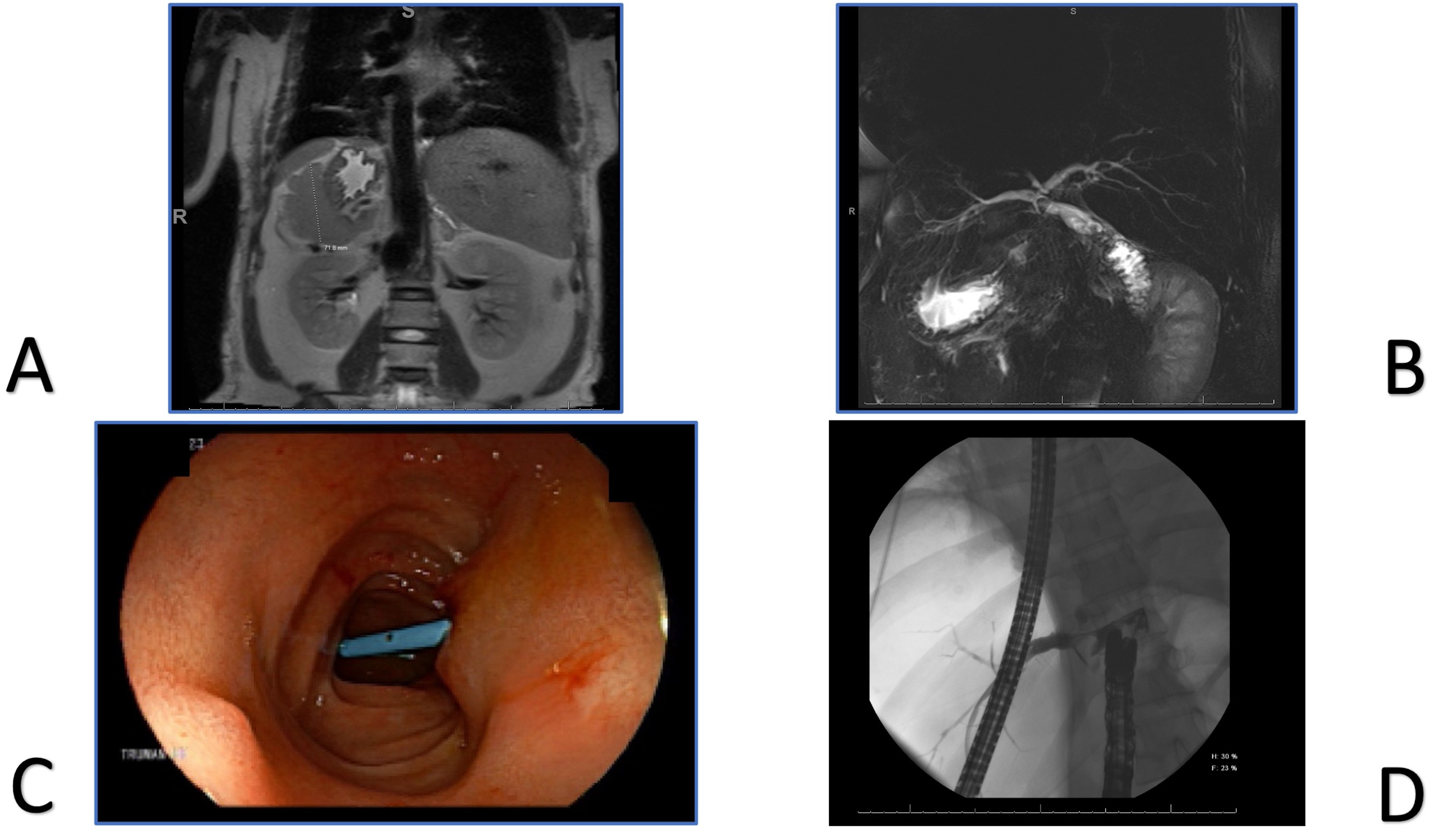Sunday Poster Session
Category: Interventional Endoscopy
P0877 - ERCP in a Patient With Heterotaxy Syndrome: A New Twist
Sunday, October 22, 2023
3:30 PM - 7:00 PM PT
Location: Exhibit Hall

Has Audio

Vinay Jahagirdar, MD
University of Missouri-Kansas City
Kansas City, MO
Presenting Author(s)
Vinay Jahagirdar, MD, Lakshmi Priya, MD, Islam Mohamed, MD, Thomas Bierman, MD, John Campbell, MD, Palmer Quinton, MD, Tariku Woldey, MD, Hassan Ghoz, MD, Esmat Sadeddin, MD
University of Missouri-Kansas City, Kansas City, MO
Introduction: Heterotaxy is a condition where the thoracoabdominal organs are abnormally arranged across the left (L)-right (R) axis of the body. L isomerism is a subset of heterotaxy where some paired structures are symmetrical mirror images of each other and have the morphology of normal L-sided structures. Unlike R isomerism, cardiac abnormalities in L isomerism are milder, and patients may never be diagnosed with it, till imaging is done for other causes. Here we describe a patient presenting with choledocholithiasis, who was incidentally diagnosed with L-isomerism heterotaxy syndrome, and the technical challenges faced during ERCP.
Case Description/Methods: A 37yo F with no PMH presented to the ED with RUQ pain for 1 day. Pain was associated with food intake. Labs included WBC of 18x10^3/cmm. LFTs and lipase were normal. US showed CBD dilatation and cholelithiasis. MRCP confirmed choledocholithiasis with CBD dilation. Heterotaxia syndrome with left isomerism was incidentally noted – patient had multilobed spleen in R abdomen with R sided gastric positioning.
Gastritis was noted on EGD. An ERCP was performed in semi prone position which was technically challenging due to the anatomy. Stomach was deformed and J-shaped. Cannulating the ampulla took multiple attempts. Sludge was extracted post sphincterotomy and balloon sweeping. Due to the altered geography and difficulty in obtaining a good cholangiogram image. Biliary stent was placed. Patient was later discharged with plans for outpatient cholecystectomy given her clinical stability.
1 month later, the patient presented again with similar complaints of RUQ pain. This time she was febrile with leukocytosis. CT abdomen showed perforated cholecystitis. Patient underwent cholecystectomy. On repeat ERCP sphincterotomy was extended to extract multiple stones and new CBD stent placed. Patient improved clinically and was discharged with plan for biliary stent removal.
Discussion: While situs inversus involves complete transposition of all visceral organs, heterotaxy describes any deviation from the standard placement of organs. L isomerism tends to present late, even in adulthood, since it is less associated with congenital heart disease. Given that endoscopic instruments are designed for the papilla at the medial side of the duodenum, ERCP can be technically challenging. Case reports have described alternative patient positions, and endoscopy techniques. EGD prior to ERCP helps visualize the anatomy to perform a successful ERCP.

Disclosures:
Vinay Jahagirdar, MD, Lakshmi Priya, MD, Islam Mohamed, MD, Thomas Bierman, MD, John Campbell, MD, Palmer Quinton, MD, Tariku Woldey, MD, Hassan Ghoz, MD, Esmat Sadeddin, MD. P0877 - ERCP in a Patient With Heterotaxy Syndrome: A New Twist, ACG 2023 Annual Scientific Meeting Abstracts. Vancouver, BC, Canada: American College of Gastroenterology.
University of Missouri-Kansas City, Kansas City, MO
Introduction: Heterotaxy is a condition where the thoracoabdominal organs are abnormally arranged across the left (L)-right (R) axis of the body. L isomerism is a subset of heterotaxy where some paired structures are symmetrical mirror images of each other and have the morphology of normal L-sided structures. Unlike R isomerism, cardiac abnormalities in L isomerism are milder, and patients may never be diagnosed with it, till imaging is done for other causes. Here we describe a patient presenting with choledocholithiasis, who was incidentally diagnosed with L-isomerism heterotaxy syndrome, and the technical challenges faced during ERCP.
Case Description/Methods: A 37yo F with no PMH presented to the ED with RUQ pain for 1 day. Pain was associated with food intake. Labs included WBC of 18x10^3/cmm. LFTs and lipase were normal. US showed CBD dilatation and cholelithiasis. MRCP confirmed choledocholithiasis with CBD dilation. Heterotaxia syndrome with left isomerism was incidentally noted – patient had multilobed spleen in R abdomen with R sided gastric positioning.
Gastritis was noted on EGD. An ERCP was performed in semi prone position which was technically challenging due to the anatomy. Stomach was deformed and J-shaped. Cannulating the ampulla took multiple attempts. Sludge was extracted post sphincterotomy and balloon sweeping. Due to the altered geography and difficulty in obtaining a good cholangiogram image. Biliary stent was placed. Patient was later discharged with plans for outpatient cholecystectomy given her clinical stability.
1 month later, the patient presented again with similar complaints of RUQ pain. This time she was febrile with leukocytosis. CT abdomen showed perforated cholecystitis. Patient underwent cholecystectomy. On repeat ERCP sphincterotomy was extended to extract multiple stones and new CBD stent placed. Patient improved clinically and was discharged with plan for biliary stent removal.
Discussion: While situs inversus involves complete transposition of all visceral organs, heterotaxy describes any deviation from the standard placement of organs. L isomerism tends to present late, even in adulthood, since it is less associated with congenital heart disease. Given that endoscopic instruments are designed for the papilla at the medial side of the duodenum, ERCP can be technically challenging. Case reports have described alternative patient positions, and endoscopy techniques. EGD prior to ERCP helps visualize the anatomy to perform a successful ERCP.

Figure: A: MRI showing multilobulated spleen in right abdomen. B: MRCP, with bile ducts extending towards left flank C: Plastic biliary stent protruding from the lateral major papilla D: Cholangiogram showing abnormal orientation of biliary tree
Disclosures:
Vinay Jahagirdar indicated no relevant financial relationships.
Lakshmi Priya indicated no relevant financial relationships.
Islam Mohamed indicated no relevant financial relationships.
Thomas Bierman indicated no relevant financial relationships.
John Campbell indicated no relevant financial relationships.
Palmer Quinton indicated no relevant financial relationships.
Tariku Woldey indicated no relevant financial relationships.
Hassan Ghoz indicated no relevant financial relationships.
Esmat Sadeddin indicated no relevant financial relationships.
Vinay Jahagirdar, MD, Lakshmi Priya, MD, Islam Mohamed, MD, Thomas Bierman, MD, John Campbell, MD, Palmer Quinton, MD, Tariku Woldey, MD, Hassan Ghoz, MD, Esmat Sadeddin, MD. P0877 - ERCP in a Patient With Heterotaxy Syndrome: A New Twist, ACG 2023 Annual Scientific Meeting Abstracts. Vancouver, BC, Canada: American College of Gastroenterology.
